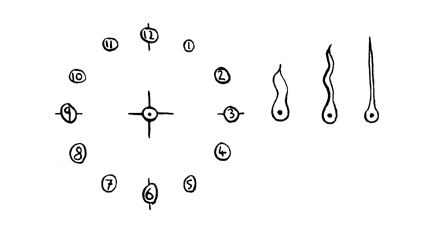I finally had a chance to do some more Actionscript coding for the Chumby again. The last widget I did was the bare minimum to get going and this one is only a little more advanced. In particular it's a simple analogue clock. All it does is show the current time, nothing more, but it does involve a few more "moving parts" than were involved in the "Hello World" widget from last time.
So to start off with here's the scaled down scan I used for the clock face and hands:
I cut out the face and hands and put them into separate files (see .tar.gz below) for using in the Actionscript. All images were 24bit PNGs with variable alpha transparency, so that the edges look nice and smooth on the Chumby screen (which is relatively low resolution).
The Actionscript (ChumbyClock.as) is very simple and looks like this:
class ChumbyClock extends MovieClip {
var hourHand:MovieClip;
var minHand:MovieClip;
var secHand:MovieClip;
function onLoad() {
this.hourHand = loadHand('hour_hand');
this.minHand = loadHand('minute_hand');
this.secHand = loadHand('second_hand');
}
function loadHand(hand_id:String) {
var clip = this.createEmptyMovieClip("clip", this.getNextHighestDepth());
clip._x = 160;
clip._y = 120;
// load image an shift it to be in 12 o'clock position
// with 0,0 as middle of bottom of image
var hand = clip.attachMovie(hand_id, 'hand', clip.getNextHighestDepth());
hand._x = -hand._width/2;
hand._y = -hand._height + (hand._width/2);
return clip;
}
function toDegrees(val:Number, range:Number) {
return (360*(val % range))/range;
}
function onEnterFrame() {
var now:Date = new Date();
var sec:Number = now.getSeconds();
secHand._rotation = toDegrees(sec, 60);
var min:Number = now.getMinutes();
minHand._rotation = toDegrees(min, 60);
// let hour hand move a little bit with min hand
var hourWithMin:Number = now.getHours() + min/60.0;
hourHand._rotation = toDegrees(hourWithMin, 12);
}
}
All this does is create three movies which contain the hand images, placed so they are in the 12 O'Clock position. At each timestep (onEnterFrame) the current time is queried and the hand rotations are updated. The second and minute hands are just rotated in proportion with the relevant values. The hour hand is also slightly rotated with the current minute. As we get nearer the end of the hour, the hour hand moves nearer to the next hour. Much as you'd expected for a real clock. That's it. I did play around with having smoother animation for the hands, but it looked a bit eery.
To tie the Actionscript and images together there is an xml file (app.xml) used by swfmill:
<?xml version="1.0" encoding="utf-8" ?>
<movie width="320" height="240" framerate="12">
<background color="#ffffff"/>
<clip import="build/classes.swf" />
<frame>
<library>
<clip id="face" import="images/hand_drawn/face.png" />
<clip id="hour_hand" import="images/hand_drawn/hour_hand.png" />
<clip id="minute_hand" import="images/hand_drawn/minute_hand.png"/>
<clip id="second_hand" import="images/hand_drawn/second_hand.png"/>
<clip id="app" class="ChumbyClock" />
</library>
<place id="face" name="clockFace" depth="0" />
<place id="app" name="myApp" depth="1" />
</frame>
</movie>
This will allow us to embed the PNGs in the generated SWF file and reference them from the Actionscript. In addition the clock face image is placed statically behind the main movie of the hands.
These files are then run through a build script to generate the SWF:
~/bin/mtasc-1.12-osx/mtasc -swf build/classes.swf -header 320:240:12 ChumbyClock.as ~/bin/swfmill-0.2.12-macosx/swfmill simple app.xml chumbyclock.swf
Here's the generated SWF:
To test this on the Chumby I put the SWF on a memory stick along with this debugchumby script:
#!/bin/sh chumbyflashplayer.x -i /mnt/usb/chumbyclock.swf
Then when the Chumby is rebooted with the memory stick in the clock displays and all is good.
So there you go that's a simple clock widget for the Chumby - using open source tools.
